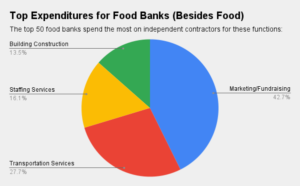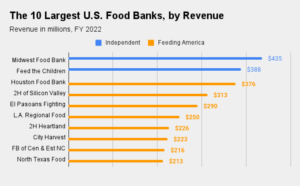Welcome to the Food Bank News list of the largest 300 food banks in America, by revenue.
We’ve compiled this resource as a way to better understand the organizations that have become so critical to fighting food insecurity across the country. From a single organization formed about 50 years ago, the food-banking network has evolved into an essential part of the fabric of our society. What do we know about this network as a whole?
First of all, it’s larger than many people might think. While many may be familiar with the fact that 200 food banks make up the Feeding America network, there are other types of food banks out there. In addition to the 200 of Feeding America, there are about 70 “partner distribution organizations.” (These are also listed on the Feeding America website, though not all of them fall within the top 300.) These entities are generally smaller in size than the 200 that make up Feeding America’s primary list, but they are nonetheless food banks, working with the main 200 to help distribute food more locally.
In addition to those two sets of food banks, there are dozens of independent food banks across the country. We counted 57 of them within the top 300. Many independents are on the small side, but a handful are huge. Two of them — Feed the Children of Oklahoma and Midwest Food Bank of Illinois — are the largest in the country. Another, Farm Share of Florida, is the twelfth biggest.
The upshot is that the total number of food banks in the country is well over 300. (We just stopped counting at 300). We also did not include the dozens (hundreds?) of operations around the country that focus specifically on fresh-food rescue, whether from farms, restaurants or backyard fruit trees. Future assessments of the size of the hunger-relief sector would ideally include these entities as well, since they accomplish the same goal of getting food to people who need it.
To create our ranking, we relied on revenue as the benchmark for better understanding the food-banking sector. Revenue has the benefit of being a standard measure reported annually, creating a common baseline.
Revenue for a food bank is not the same as revenue generated by a private or public company. Most of a food bank’s “revenue” comes in the form of in-kind food donations, which of course get immediately distributed out. Other significant chunks of revenue come in the form of government and foundation grants, and donations from individuals.
Food donations and distributions were amplified during Covid, with Feeding America reporting that the food banks within its network distributed more than 6 billion meals in 2020, an increase of 44% from the year before. Covid also super-charged donations from individuals, as well as grants from foundations and government.
As a result, total revenue for all of the top 300 food banks increased dramatically during fiscal year 2020, by nearly $4 billion ($3.93 billion) to a total of more than $14.7 billion. The top two food banks recorded more than $400 million of revenue, with the largest having $467 million. Food bank #300 had about $4 million. As noted earlier, there are many more food banks (with $4 million or less of revenue) that could be added to the list, but this project does not encompass them all.
With all of these food and cash resources, there comes influence. Even as the economic distress of Covid-19 fades, food banks will still wield enormous power in their ability to help people via the food they decide to distribute and the programs they decide to fund and promote.
Which food banks are the ones with the most resources? For the most part, the 20 largest food banks by 2020 revenue are somewhat the same as those on our 2019 list. Four of them are in Florida, three are in Texas, and three are in Illinois. You can check them out here.
It’s worth noting that food bank revenue numbers are impacted by the timing of tax filings. Most food banks use a fiscal year running from July 1 through June 30, so a good amount of the food donations, fundraising and government aid that was generated through Covid will be apparent in next year’s filings.
Food banks that file according to a calendar year naturally showed a bigger revenue boost because they benefited from more months of 2020 Covid-related giving and government aid. Two food banks among the top 20 filing according to a calendar year, for example, are the second- and third-largest.
Our Top 300 list expands upon the Top 100 list published last year. It also is much more advanced from a technology standpoint. This list, published as a Tableau data dashboard, offers several cuts of the data and the ability to make queries in an interactive manner. It shows:
The Top 100 food banks
Food banks from #101 to #300
Food banks by state
Independent food banks within the Top 300
and more
For this added sophistication we give deep thanks to Justin Gilmore, a technology professional with a talent for using data to inspire action, who freely gave of his time and expertise to spearhead this Tableau rollout. We also give sincere thanks and gratitude to Zachary Smith, Food Bank News intern, who spent many hours gathering and organizing the data with care and dedication.
With the list, we hope to advance knowledge and understanding of all the players working to solve food insecurity in America. Check it out here!
Like what you’re reading?
Support Food Bank News








